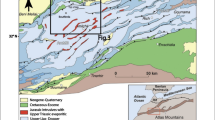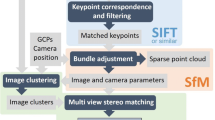Abstract
The grain size distribution (GSD) of a river bed is fundamental information required for studies of fluvial, morphological, and ecological processes. To achieve higher efficiency, numerous efforts have been devoted to developing the techniques of automated grain sizing. These techniques can be categorized as the image-based or topography-based approach according to the input data used. Each category is further subdivided into three groups based on the output result, namely: individual GSD, statistical GSD, or characteristic grain sizes. Existing software for automated grain sizing covers the image-based approaches for all three types of output, and topography-based approaches for statistical GSD and characteristic grain sizes. To date, however, no software has been developed that uses 3D topographic data to delineate individual grains and estimate their GSD. Here, we present a first-ever topography-based software tool, FKgrain, for automated grain segmentation and sizing. FKgrain adopts factorial kriging to decompose the grain-scale component of digital elevation model (DEM), whose zero-level contours are then used as the input for morphological grain segmentation. FKgrain exports the shapefiles of the delineated grains and their ellipse fits, whose minor axes can be used to derive the individual GSD. An application example demonstrates that FKgrain is efficient in producing useful results that are comparable to those obtained by traditional, time-consuming and laborious manual digitization of grain images.







Similar content being viewed by others
Data availability
The data/material used in this work are available on GitHub: https://github.com/ncku-arsem/FKgrain.
Code availability
The source codes and executable are available on GitHub: https://github.com/ncku-arsem/FKgrain.
References
Brasington J, Vericat D, Rychkov I (2012) Modeling river bed morphology, roughness, and surface sedimentology using high resolution terrestrial laser scanning. Water Resour Res 48:W11519. https://doi.org/10.1029/2012WR012223
Bunte K, Abt SR (2001) Sampling surface and subsurface particle-size distributions in wadable gravel- and cobble-bed streams for analysis in sediment transport, hydraulics, and streambed monitoring. General Technical Report RMRS-GTR-74. USDA Forest Service, Rocky Mountain Research Station, Fort Collins, CO, p 428. https://www.fs.usda.gov/treesearch/pubs/4580
Buscombe D (2008) Estimation of grain-size distributions and associated parameters from digital images of sediment. Sed Geol 210:1–10
Buscombe D (2013) Transferable wavelet method for grain-size distribution from images of sediment surfaces and thin sections, and other natural granular patterns. Sedimentology 60:1709–1732
Buscombe D (2016) Spatially explicit spectral analysis of point clouds and geospatial data. Comput Geosci 86:92–108
Buscombe D (2020) SediNet: a configurable deep learning model for mixed qualitative and quantitative optical granulometry. Earth Surf Process Landforms 45:638–651
Buscombe D, Rubin DM, Warrick JA (2010) A universal approximation of grain size from images of noncohesive sediment. J Geophys Res 115:F02015. https://doi.org/10.1029/2009JF001477
Buscombe D, Rubin DM (2012) Advances in the simulation and automated measurement of well-sorted granular material: 2. Direct measures of particle properties. J Geophys Res 117:F02002. https://doi.org/10.1029/2011JF001975
Butler JB, Lane SN, Chandler JH (2001) Automated extraction of grain-size data from gravel surfaces using digital image processing. J Hydraul Res 39:519–529
Carbonneau PE, Lane SN, Bergeron NE (2004) Catchment-scale mapping of surface grain size in gravel bed rivers using airborne digital imagery. Water Resour Res 40:W07202. https://doi.org/10.1029/2003WR002759
Chardon V, Schmitt L, Piégay H, Lague D (2020) Use of terrestrial photosieving and airborne topographic LiDAR to assess bed grain size in large rivers: a study on the Rhine River. Earth Surf Process Landforms 45:2314–2330
Detert M, Weitbrecht V (2012) Automatic object detection to analyze the geometry of gravel grains – a free stand- alone tool. In: Muños RM (ed) River flow 2012. Taylor & Francis, pp 595–600. https://www.taylorfrancis.com/books/mono/10.1201/b13250/river-flow-2012-rafael-murillo-munoz
Detert M, Weitbrecht V (2013) User guide to gravelometric image analysis by BASEGRAIN. In: Fukuoka S, Nakagawa H, Sumi T, Zhang H (eds) Advances in river sediment research. Taylor & Francis, pp 1789–1795. https://www.taylorfrancis.com/books/mono/10.1201/b15374/advances-riversediment-research-shoji-fukuoka-hajime-nakagawa-tetsuya-sumi-hao-zhang
Entwistle NS, Heritage GL, Johnson K, Hetherington D (2007) Repeat terrestrial laser scanner survey of pebble cluster creation and formation in response to flow change. Proceedings of the Annual Conference. Remote Sensing and Photogrammetry Society, Nottingham
Fehr R (1987) Einfache Bestimmung der Korngrössenverteilung von Geschiebematerial mit Hilfe der Linienzahlanalyse [Simple detection of grain size distribution of sediment material using line-count analysis]. Schweizer Ingenieur Und Architekt 105:1104–1109 ((in German))
Graham DJ, Reid I, Rice SP (2005a) Automated sizing of coarse-grained sediments: Image-processing procedures. Math Geol 37:1–28
Graham DJ, Rice SP, Reid I (2005b) A transferable method for the automated grain sizing of river gravels. Water Resour Res 41:W07020. https://doi.org/10.1029/2004WR003868
Heritage GL, Milan DJ (2009) Terrestrial Laser Scanning of grain roughness in a gravel-bed river. Geomorphology 113:4–11
Hodge R, Brasington J, Richards K (2009a) Analysing laser-scanned digital terrain models of gravel bed surfaces: linking morphology to sediment transport processes and hydraulics. Sedimentology 56:2024–2043
Hodge R, Brasington J, Richards K (2009b) In situ characterization of grain-scale fluvial morphology using Terrestrial Laser Scanning. Earth Surf Process Landforms 34:954–968
Huang G-H, Wang C-K (2012) Multiscale geostatistical estimation of gravel-bed roughness from terrestrial and airborne laser scanning. IEEE Geosci Remote Sens Lett 9:1084–1088
Ibbeken H, Schleyer R (1986) Photo-sieving: a method for grain-size analysis of coarse-grained, unconsolidated bedding surfaces. Earth Surf Proc Land 11:59–77
Lang N, Irniger A, Rozniak A, Hunziker R, Wegner JD, Schindler K (2021) GRAINet: Mapping grain size distributions in river beds from UAV images with convolutional neural networks. Hydrol Earth Syst Sci 25:2567–2597
Lo HP, Wang C-K, Wu F-C (2021) FKgrain user’s manual (version 2021/6/8). https://github.com/ncku-arsem/FKgrain. Accessed 10 June 2021
McEwan IK, Sheen TM, Cunningham GJ, Allen AR (2000) Estimating the size composition of sediment surfaces through image analysis. Proc. Instn Civ. Engrs Water & Mar Engng 142:189–195
Pearson E, Smith MW, Klaar MJ, Brown LE (2017) Can high resolution 3D topographic surveys provide reliable grain size estimates in gravel bed rivers? Geomorphology 293:143–155
Purinton B, Bookhagen B (2019) Introducing PebbleCounts: a grain-sizing tool for photo surveys of dynamic gravel-bed rivers. Earth Surf Dynam 7:859–877. https://doi.org/10.5194/esurf-7-859-2019
Rubin DM (2004) A simple autocorrelation algorithm for determining grain size from digital images of sediment. J Sediment Res 74:160–165
Rychkov I, Brasington J, Vericat D (2012) Computational and methodological aspects of terrestrial surface analysis based on point clouds. Comput Geosci 42:64–70
Sime LC, Ferguson RI (2003) Information on grain sizes in gravel-bed rivers by automated image analysis. J Sediment Res 73:630–636
Strom KB, Kuhns RD, Lucas HJ (2010) Comparison of automated image-based grain sizing to standard pebble-count methods. J Hydraul Eng 136:461–473
Wang C-K, Wu F-C, Huang G-H, Lee C-Y (2011) Mesoscale terrestrial laser scanning of fluvial gravel surfaces. IEEE Geosci Remote Sens Lett 8:1075–1079
Warrick JA, Rubin DM, Ruggiero P, Harney JN, Draut AE, Buscombe D (2009) Cobble cam: grain-size measurements of sand to boulder from digital photographs and autocorrelation analyses. Earth Surf Process Landforms 34:1811–1821
Wolman MG (1954) A method of sampling coarse river-bed material. EOS Trans Am Geophys Union 35:951–956
Woodget AS, Austrums R (2017) Subaerial gravel size measurement using topographic data derived from a UAV-SfM approach. Earth Surf Process Landforms 42:1434–1443
Wu F-C, Wang C-K, Huang G-H (2018) Delineation of gravel-bed clusters via factorial kriging. Geomorphology 308:161–174
Acknowledgements
This work was supported by the Ministry of Science and Technology (MOST), Taiwan, granted to FCW (106-2221-E-002 -074 -MY3). We thank Guo-Hao Huang for the source codes of FK used in Part 1 of the software. Comments and suggestions from anonymous reviewers are acknowledged.
Funding
This research was supported by the Ministry of Science and Technology (MOST), Taiwan, granted to Fu-Chun Wu (Grant number: 106–2221-E-002 -074 -MY3).
Author information
Authors and Affiliations
Contributions
Fu-Chun Wu contributes to research conception, supervision of software development, result analysis and interpretation, writing and editing manuscript, revisiting user’s manual, and funding acquisition. Chi-Kuei Wang contributes to data acquisition, methodology, supervision of software development, drafting user’s manual, and resources provision. Hong Ping Lo contributes to software coding and implementation, preparing and drafting user’s manual. All authors approve the manuscript version submitted and take intellectual responsibility for its content.
Corresponding author
Ethics declarations
Conflicts of interest/Competing interests
The authors declare no conflict of interest.
Additional information
Communicated by: H.Babaie
Publisher's note
Springer Nature remains neutral with regard to jurisdictional claims in published maps and institutional affiliations.
Rights and permissions
About this article
Cite this article
Wu, FC., Wang, CK. & Lo, H.P. FKgrain: A topography-based software tool for grain segmentation and sizing using factorial kriging. Earth Sci Inform 14, 2411–2421 (2021). https://doi.org/10.1007/s12145-021-00660-z
Received:
Accepted:
Published:
Issue Date:
DOI: https://doi.org/10.1007/s12145-021-00660-z




